Driver's a G - Growth
1/145
There's no tags or description
Looks like no tags are added yet.
Name | Mastery | Learn | Test | Matching | Spaced |
|---|
No study sessions yet.
146 Terms
Sigmoidal Growth Curve:
shaped like an “S” - shows the cumulative weight of the animal over time
Sigmoidal growth curves are actually ______ _________.
stair stepped
Why are sigmoidal growth curves stairstepped?
growth occurs in spurts due to the sporadic nature of growth
What can impact growth in an animal?
environment
disease or health state
nutritional intake
hormone function
What are the 3 segments of the sigmoidal growth curve?
Self-accelerating
Point of Inflection
Self-inhibiting
Self-Accelerating Phase:
characterized by exponential but non-complex growth that occurs in the early stages of development
Why does growth begin to slow as it nears the point of inflection?
Harder to supply the rapidly dividing cells with nutrients, oxygen, and blood
Harder to get rid of cellular waste products
Point of Inflection:
period of greatest average daily gain - occurs during puberty in most species
After the point of inflection, growth continues at a __________ rate.
decreasing
Why does growth slow during the self-inhibiting phase?
the animal is reaching its mature size and nutrient intake is nearing maintenance requirement
What hormone secreted by the hypothalamus reduces growth?
somatostatin (GHIH)
Asymptote:
the point at which food intake reaches the maintenance requirement - animal has hit its mature body weight
Chronological Age:
age in absolute time units (days, months, years)
What factors can change an animals chronological growth curve?
nutrition, disease, stress, and activity level
Physiological Age:
the specific physical or chemical stages of maturity (height, weight, composition, puberty)
How do chronological and physiological age relate?
animals of different species will reach different physiological levels of maturity at different chronological time points
Cumulative Growth Curve:
plots the animals total weight over time - usually a sigmoidal “S” shaped curve
What is one weakness of using a cumulative growth curve?
hard to identify the period of maximum growth (point of inflection)
Absolute Growth Curve:
plots the gain per unit of time against time - ADG per week, month, etc.
What is one weakness of absolute growth curves?
the growth rate changes as the animal grows - only accurate if the time intervals are short
Relative Growth Curve:
plots growth in relation to total weight - growth rate per unit of weight plotted against time
As an animal grows, its relative growth rate ________.
decreases
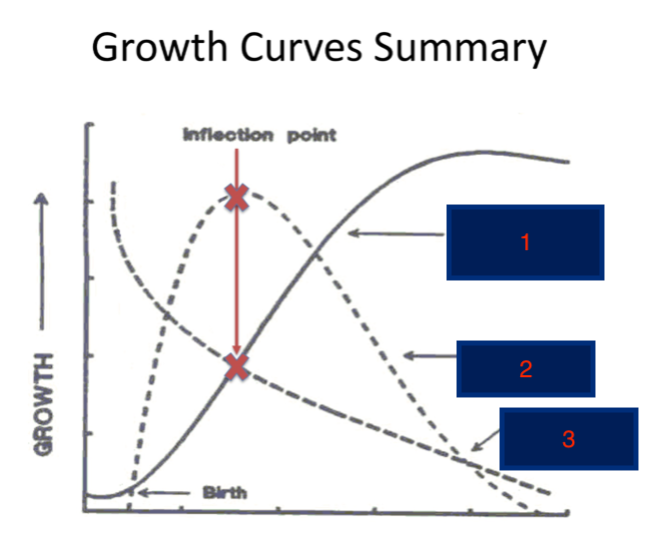
What type of growth curve is #1?
Cumulative
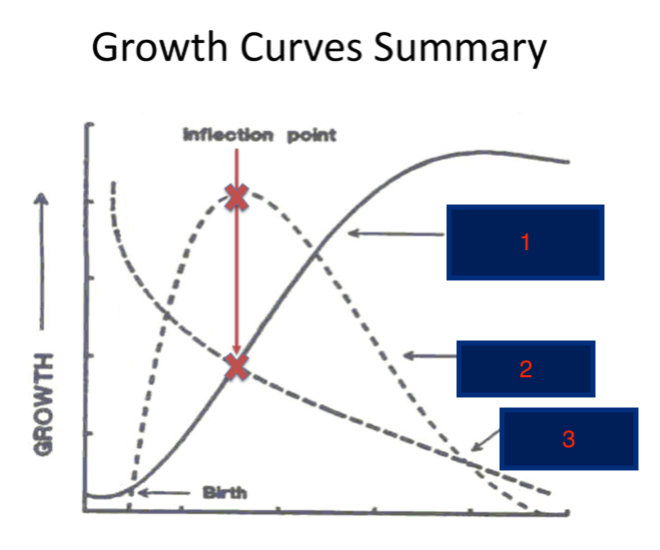
What type of growth curve is #2?
Absolute
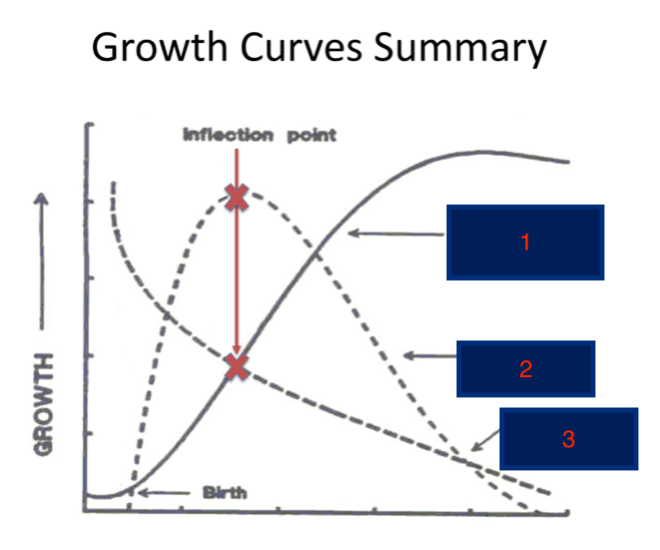
What type of growth curve is #3?
Relative
What were John Hammonds two important observations?
Body components that are physiologically more important develop first
Extremities complete their development first
How did John Hammond study compositional growth changes?
animals were raised under typical conditions of environment or nutrition OR were raised in malnourished conditions
Allometric Growth:
the study of how body parts change in size as an animal develops - the study of body proportions
Who first described allometric growth?
Julian Huxley
How did Huxley come up with the allometric growth theory?
studied how the fighting claw of fiddler crabs grew in relation to whole body growth
What is the basic allometric growth equation?
Y = axb
A _______ relationship exists between growth of each __________ and the whole body.
constant; tissue/organ
How does allometric growth apply to muscle development?
different muscles develop faster or slower depending on the species
Isometric tissues/organs develop…
at the same rate as the whole body (b=1)
Hammond proved that which tissue doesn’t follow the allometric growth theory?
adipose tissue
Which tissues recieve first “dibs” on the nutrients in the blood stream?
Brain and central nervous system
Placenta and fetus in pregnant females
Which tissue gets last “dibs” on nutrients in the blood stream?
adipose/fat tissue
In the forumla y=axb, Y stands for:
log weight of a carcass or animal
In the forumla y=axb, A stands for:
constant weight of tissue or component
In the forumla y=axb, B stands for:
growth coefficient of tissue or component - indicates the slope of the line
(B > 1) =
tissue or component is growing at a faster rate and has a high growth impetus (late developing tissue)
(B = 1) =
tissue or component is growing at a similar rate to the whole with an average growth impetus (isometric growth)
(B < 1) =
tissue or component is growing at a slower rate and has a low growth impetus (early developing tissue)
How does the maximum growth rate differ among tissue?
different tissues reach max growth rate at different times during development (bone > muscle > fat)
How can composition of growth be measured using absolute growth curves?
the cumulative weight of muscle, bone, and fat over time indicates which tissues are growing in relation to the overall weight of the animal and how their proportions change throughout development.
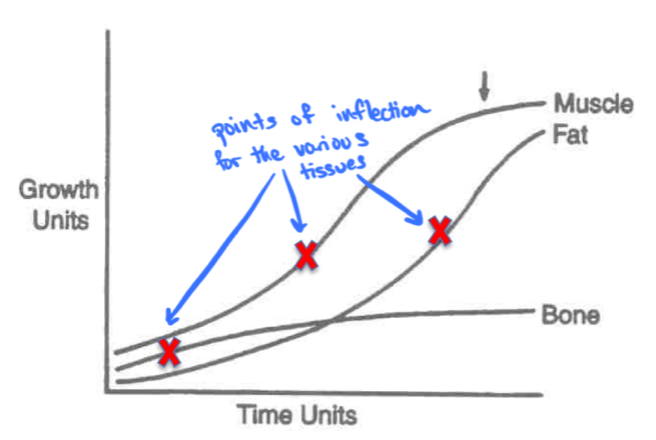
How can composition of growth be measured on a percentage basis?
by analyzing the percentage of each tissue type relative to total body weight at various stages of development - adds up to 100% at any given time point
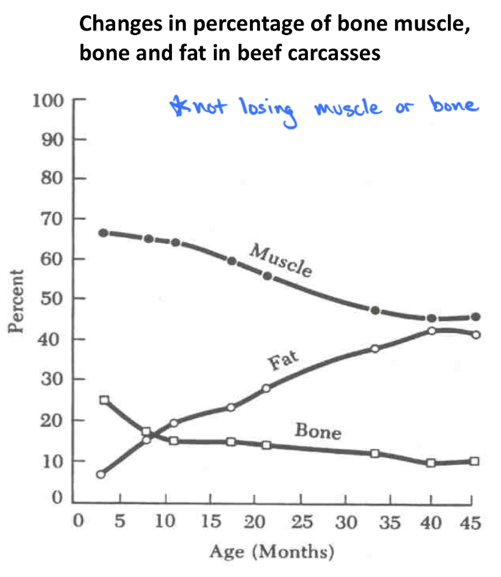
Fat becomes a _______ proportion of the body with age.
larger
Muscle and bone makeup a _______ proportion of the body with age.
smaller
Water and protein make up a ________ portion of the body with age.
smaller
Water content of muscle, fat, and bone is greatest ______ in life and _________ with age.
early; decreases
Where is most extra fat stored in the body?
subcutaneous and mesenteric fat stores
What is the order in which adipose stores reach maturity? (which ones fill first)
kidney > mesenteric > subcutaneous > intermuscular > intramuscular
Does the # of adipocytes increase with age?
NO - amount of fat accumulation in each adipocyte does
Mineral content in bone ________ with age.
increases (ossification of cartilage)
The absolute amount of ___________ _______ increases with age.
connective tissue
As muscle atrophies, the _______ of connective tissue increases, but the ________ amount stays the same. This is known as the ________ ________.
percentage; absolute; dilution effect
Phenotype = _________ x __________
genotype; environment
Species:
organisms capable of interbreeding and producing fertile offspring
Breed:
subsets of organisms within a species that have the same chromosome #, but differing genetic codes, traits, behaviors, etc.
Heredity:
the process of passing along genes from one generation to the next
Evolution:
the gradual change in species over time through natural selection and adaptation, leading to the diversification of life and the emergence of new species
Genotype:
the unique set of genes that an animal possess in its genome
Heritability:
the ability of an animal to pass a particular trait to the next generation
H > 0.5 = a ______ heritable trait
highly
0.2 < H < 0.5 = a ______ heritable trait
moderately
H < 0.2 = a ______ heritable trait
lowly
Selection and domestication has caused a change in the ________ __________ of muscle.
relative distribution
How do wild ruminants differ in muscle distribution compared to domestic ones?
have a greater % of muscle located in the upper portions of the hind legs - enhances speed and agility to escape predators
How has muscle distribution changed in domesticated ruminants?
greater % of muscle in abdominal muscles to support their extensive rumens and in front legs to bear weight associated with grazing for long periods of time
Where do pigs have increased muscle deposition?
around the spinal column - supports rooting behavior
Cattle and sheep favor ___________ and ___________ fat depos.
intermuscular and subcutaneous
Swine favor __________ fat depos.
subcutaneous
Poultry have ______ _________ fat depos.
evenly distributed (between kidney, intermusuclar, subcutaneous) to support flight
What were cattle domesticated from and when?
Aurochs around 8500 BC
Where was Bos Taurus domesticated?
the fertile crescent
Where were Bos Indicus domesticated?
India
What was the first trait selected for in domesticated cattle?
docility
What are the two types of cattle with regards to skeletal size?
large-framed (Continental) and small-framed (British)
How many frame scores are there in cattle?
7
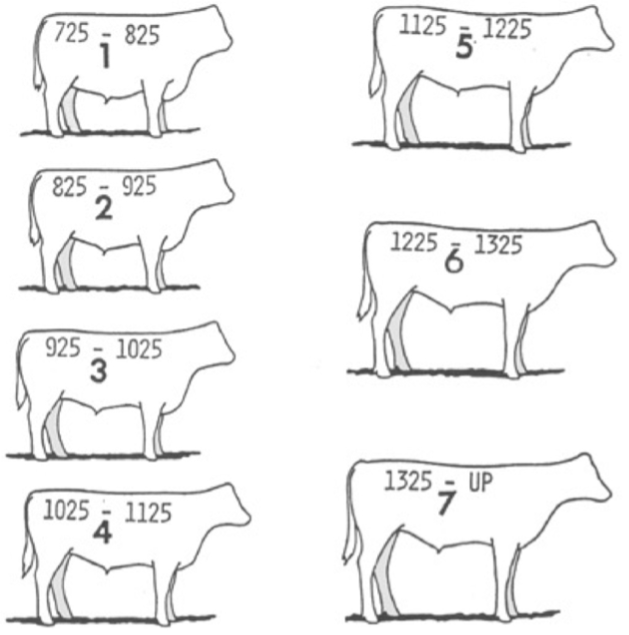
What is the purpose of assigning a frame score?
To categorize cattle based on skeletal size and growth potential - aids in breeding and management decisions
Frame score is determined using…
Age + Hip Height
Large framed cattle reach a heavier weight at a given…
chronological age
Large-framed cattle take ______ to reach physiological maturity compared small-framed cattle.
longer
At the same chronological age, how do large- and small-framed cattle compare?
Large-framed will be physiologically more immature (leaner) because they are later-maturing animals - have more growing to do overall
When compared at the same physiological age, small- and large-framed cattle are…
compositionally equivalent (muscle:fat ratio is the same)
In cattle, how does selection for muscle impact milk production?
selection for muscle is inversely related to milk production - meat breeds are poor milk producers
How have muscle fibers been affected in milk breeds (cattle)?
selection for milk production caused a reduction in muscle fiber #’s that occurs prenatally (during gestation development)
How has muscle distribution changed in milk breeds?
it hasn’t - only the size (# of fibers) in each muscle group
How is wool selection related to muscle in sheep?
selection for wool production is inversely related to muscle growth - wool breeds vs. meat breeds
Which has the larger frame size, wool or meat breeds? (sheep)
Wool breeds
How does muscle selection impact reproduction in swine?
inverse relationship - terminal and maternal breeds
Describe growth in intact males:
capable of large mature body weights than castrates or females
attain compositional maturity at a later chronological age than castrates or females
usually heavier at a given chronological age
Why do intact males grow larger and faster than castrates and females?
boost from testosterone production - nutrient partioner
How does muscle deposition differ in intact males?
have more muscle located in the forequarter (neck + thorax) - associated with secondary sex characteristics
Why do males and females differ in muscle depsotion?
have higher levels of estrogen or testosterone receptors in different muscle groups which encourages more growth in those groups
How does muscle distribution differ in females?
have a greater proportion of muscle in the pelvic limbs and abdominal wall - associated with secondary sex characteristics
How does muscle deposition differ in castrates?
have a more uniform muscle deposition throughout the body than females or intact males
Males have larger ________ ________ _________ than females or castrates.
muscle fiber diameter
Why are females smaller in frame size than intact males and castrates?
estrogen stimulates closure of the epiphyseal plates (growth plates) and suppresses chrondocytes which results in a smaller frame and earlier physiological maturity
Why do males have thicker bone diameter than females?
testosterone better stimulates periosteal bone growth